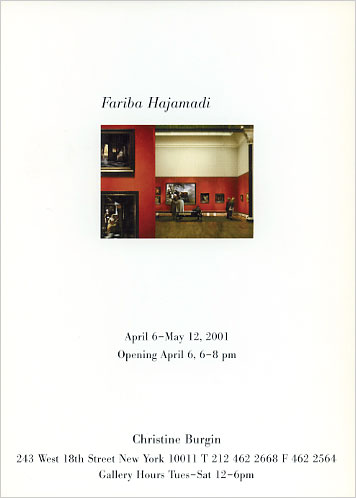
Fariba Hajamadi
April 6 - May 12, 2001
On April 6 an exhibition of new work by Fariba Hajamadi will open at the Christine Burgin Gallery.
Born in Esfahan, Iran, Hajamadi moved to the United States in 1975, graduating from the California Institute of the Arts in 1982. From the beginning, Hajamadi has used her work to investigate how one culture is collected by or, for better or worse, becomes a part of another. Her imagery -- ethnological displays, natural history collections, installations of fine art and antiquities, vitrines, descriptive panels -- are all drawn from the world of museums, a world that is central to her discussion of cultural appropriation. Straightforward documentary photographs taken by the artist form the basis of compositions that are then elaborately altered, in ways that are purposely both readable and unreadable, before being printed. As Dan Cameron writes of Hajamadi's work and her relationship to the tradition of the museum:
"Fariba Hajamadi's process of dis-orientation and de-orientalization that takes place in her work seems as comfortable a paradigm for museological practice in the coming century as any we are likely to experience. Fariba Hajamadi reclaims the artist's poetic right to describe the scene as it has been subjectively experienced. Her artistic intervention enables us to see either the object of desire or the conditions of its seizure, but never both in the same view."
In the past few years, Hajamadi has further expanded what was once a purely theoretical discussion to acknowledge her own foreign presence. In 1996 Hajamadi exhibited works at Galerie Laage Solomon in Paris and in 2000 at the Kestner Museum, Hanover, Germany in which her own larger than life self was jarringly incorporated as sculpture into the surrounding collections. In her most recent work, Hajamadi no longer physically appears in the museum space but instead creates a museum space, which is itself, a self-portrait of the artist. In one picture to be exhibited, 17th century Dutch genre painting line red velvet walls, images of domesticity, familial relationships and the actions of everyday life. In creating such an autobiographical space, Hajamadi refers to another type of painting also popular in the 17th century know as Cabinet of Amateur paintings, also popular in the 17th century. For these works, a collector would commission an artist to depict a room hung with either their actual collection, a symbolic collection or simply a collection they might dream of one day having. Similarly, Hajamadi has chosen in her new work to create her own museum, to acknowledge the unavoidable subjectivity of the act of collecting and to embrace the necessity of an emotional and personal reading.